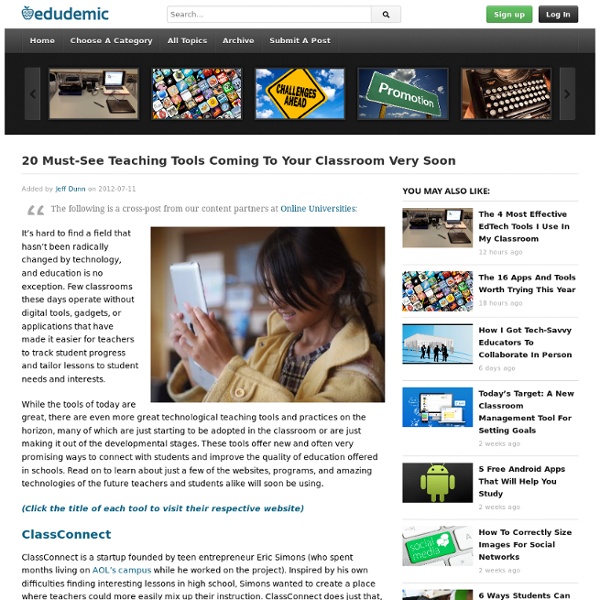10 Important Skills Students need for the Future
The future. What do our students really need to know and be able to do to succeed in future education and careers? Content is a part of what they need to know. Standardized tests test content knowledge and some skills. There are huge debates raging over standardized testing, curriculum, and the like. But what it is that students really need to know for the future. Content is important to a point. I learned many of these skills in college because even 20 years ago, my school, WPI, understood these ideas. Research by the Institute for the Future released in a report entitled “Future Work Skills 2020″ shows that preparing for a specific career area based on content is difficult and, instead, people should be developing certain broad skills. Here are the skills: Sense-making. Social intelligence. Novel and adaptive thinking. Cross-cultural competency. Computational thinking. New-media literacy. Transdisciplinarity. Cognitive load management. Virtual collaboration.
Lesson Plans - Easy, Effective Lesson Plans for Teaching Adults - Training Design
By Deb Peterson Lesson plans for adult education aren't difficult to design. Follow these easy steps and see how effective you can be. Every good course design begins with a needs assessment. Like any gathering of people for any reason, it’s good to begin at the beginning and address who is there, why they’ve gathered, what they hope to accomplish, and how they’ll accomplish it. Welcome and Introduction Build in 30 to 60 minutes at the opening of your class to conduct introductions and review your objectives and agenda. Greet participants as they arrive.Introduce yourself and ask participants to do the same, giving their name and sharing what they expect to learn from the class. Module Design Divide your material into 50-minute modules. Warm Up Warm ups are short exercises (5 minutes or shorter) that get people thinking about the topic you are about to cover. For example, if you’re teaching learning styles, a learning-style assessment would be a perfect warm up. Lecture Activity Debriefing
PLoS | Leading a transformation in research communication
Hopelink Adult Education - Resources for ESL
If your browser does not support current web standards you will not be able to view this page as it was designed. Please consider upgrading to a standards-compliant version. indicates this book is in the Hopelink Adult Education library, "R" indicates it is in the Reference section. Many of these books are also available through King County Library System. The Basic Oxford Picture Dictionary Teacher's Resource Book: Reproducible Activities by Norma Shapiro, JaymeAdelson-Goldstein, and Fiona Armstrong. Oxford University Press, 1994. Periodicals: Hands-On English Semi-monthly. indicates this book is in the Hopelink Adult Education library, "R" indicates it is in the Reference section. Easy English News Monthly, except for July and August.
Resources to Replace Textbooks
"Beyond Textbooks" is a well used mantra by educational technology companies and districts who are moving away from traditional print textbooks to digital media and resources. I don't use a textbook with my Physics classes for many reasons: the textbooks are old and outdated (but in good physical condition), the textbooks are hard to read, they are heavy, and they don't have any way to get help or expand on the material. I use a variety of materials with my Physics classes in place of the textbooks. I use Blogger and Google Sites to create a class blog and class website. Handouts with summary of concept, example problems, and problem sets for students to complete. I have no need for a physics textbook because of all of these resources. My students work on the projects and labs in groups and except for the Multimedia Science School software, have access to all of these resources at home. These kinds of resources exist for all subjects and grade levels, not just high school science.
52 Education Blogs You Should Follow
If you are a teacher, student, parent, or administrator, you should be following education blogs. Why? Simply because blogs are an ever-increasing way to spark ideas, creativity, and innovation. The following list is a compilation of blogs for those interested in education. Written by parents, administrators, businessmen, teachers, and administrators, these blogs stand out with their unique style and excellent content. Take a look at the 51 options below. Traditional Elementary Education 1. Cathy Nelson’s blog is for educators and library media specialists who are interested in technology integration in the classroom. 2. Cool Cat is a local teacher, author, and non-profit initiator, dedicated to inspiring fellow teachers with innovative and fresh ideas for reaching students in the classroom. 3. A blog centered on school administration issues. 4. A blog dedicated to educators who want a one-stop shop for all the best education blogs and resources on the Web. 5. 6. 7. 8. 9. 10. 11. 12. 13.



